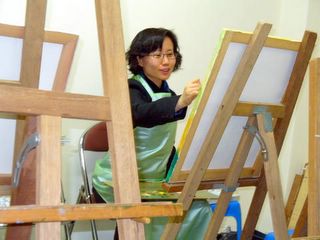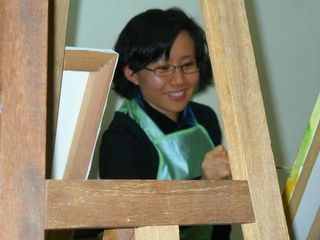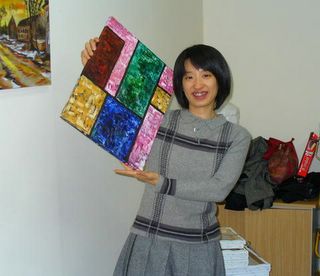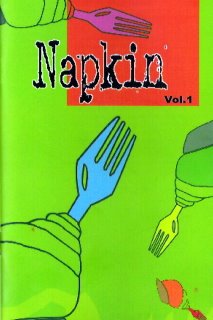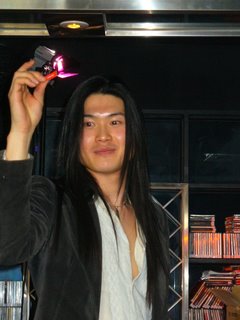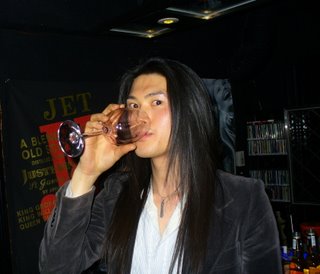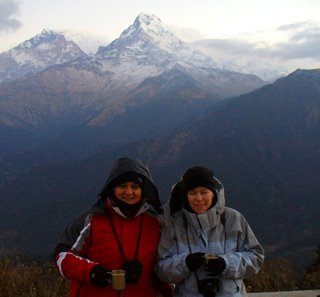
 Pictures: Clare and I just before the sunrise on Poon Hill, sipping our spiked coffee; thank god for her whiskey flask, it was freezing. The sunrise reflected on what I believe to be Annapurna I.
Pictures: Clare and I just before the sunrise on Poon Hill, sipping our spiked coffee; thank god for her whiskey flask, it was freezing. The sunrise reflected on what I believe to be Annapurna I. One aspect of my job is to edit and write for our university magazine "Hansung Today"- perhaps that's why I'm so carelell with my own blog. Isn't it the hardest part of writing: all that polishing, editing, cutting, pasting, punctuating, ...I wish we could go back to the age of quills when writers actually thought before twriting, not after. Many recent books, even the ones lauded as "true discovery and unlike anything published this year" (how many of those can we have in ONE year, I ask thee, dear reader?), have this feeling of laboriousness and forced verbosity about them. Hahaha, Got it? I could almost see a dishevelled author going back to the paragraphs of weeks before, changing this and that, coming up with most unlikely forced metaphors (which sometimes work, oddly), using his MS Word Thesaurus, checking quotes, grammar, having a dozen of editors...I wonder how many modern authors change the destiny of their characters half way through encouraged by their promoters and publisher? Ach, the Old Greats are turning in their graves. Ruhig, lieber Goethe, ruhig.
For the next edition of our mag, I had written an article about the SLA (second language acqusition) theories, but then thought the better of it. Who really cares about behaviourist, innatist, or interactionist approach to language learning? Only a linguist gets excited by phrases that sound as scientifically dry as 'crytical period hypothesis,' 'comprehensble input,' 'universal grammar,' etc. The majority of my students would have been scared away. It's a pity 'cause I also tried to give some helpful hints as how to be a successful learner, in other words what must be considered if one wants to be a successful SL learner, - you know: intelligence, aptitude, personality, attitude/motivation, that kind of stuff. I still might attempt to make it more fun and publish it a later day, we'll see.
I have no way of knowing what the readers' reaction to the replacement article would be, but I know that I enjoyed writing it much more than the SLA one. It's basically a very condensed memoir dealing with my recent trip to Nepal, slighlty- up to 2.5% max - altered for either dramatic or organizational purposes. However, everything that's mentioned is the truth, the whole truth and nothing but the truth, so help me Buddha and Brahma.
So, heeeeeeeeeeeeer's Neeeeeeepal!
*****************************************************************
A Big Adventure in a Tiny Kingdom - Trekking in Nepal
Many, many years ago I had read Johanna Spyri’s children’s classic “Heidi.” Ever since, inspired by Heidi’s adventures in the beautiful Alps, I’d been dreaming about a great hiking adventure in an exotic mountainous region. When I was old enough to browse bookstores, I’d spend hours poring over glossy travel magazines. The pictures of the Himalayas featured there are to blame for my lifelong dream of going to Nepal. On December 18th last year, accompanied by Clare, my wonderful friend and a fellow hiker, I set out on a great Nepali adventure onboard a huge Boeing headed for Katmandu, the capital of Nepal.
Before the trip, I had read everything I could lay my hands on about Nepal. I had learned that this tiny kingdom with the modest population of 10 million exists squeezed between the giant China in the north and India in the south. The country is a highly spiritual place attracting tourists with promises of mystery and adventure. Whether one longs for the peace and quiet of a Buddhist monastery in the mountains, or wants to get closer acquainted with the intricate hierarchy of the vengeful and passionate Hindu gods, or simply seeks the thrill of some of the world’s best mountain climbing, white-water rafting, rhino or tiger watching from atop an elephant, Nepal is the place to be.
For centuries, Nepal’s history has been tainted by violent political uprisings that have resulted in today’s impoverished monarchy that grants its subjects a modicum of democratic rights. It is not surprising that in such circumstances there should exist in Nepal a strong anti-monarchy and pro-communist movement, Maoism. In 2001, the already troubled kingdom was shaken to its foundations by one of the most gruesome royal massacres ever recorded in history: Dipendra, the very drunken Royal Prince and the heir to the throne, gunned down ten members of the royal family including his parents King Birendra and Queen Aishwarya, then turned the gun on himself. The reason? He had not been allowed to marry the beautiful woman he had wanted to marry. The new King Gyanendra, a brother of the murdered King, is a tough strong-liner, wildly unpopular among the majority of Nepal’s people. Political violence continues until today. As a matter of fact, when I was in Katmandu, Maoists staged bloody demonstrations against the King’s policies. A number of people died and many were injured and imprisoned.
Nepal was my first encounter with a painfully poor country. I was shocked at the sights, smells and sounds of Katmandu. What sticks most in one’s memory is the aura of fading glory still visible in the uncared for palaces, temples and mansions, but even more than that, the destitute crowds of gaunt people aimlessly milling about, squatting in tiny doorways, or standing in window frames like photographs, watching the world go by. They come from the countryside looking for better lives, ending up instead homeless, jobless and hopeless. One sees them everywhere: rummaging through piles of garbage, squatting around their cooking fires, men sometimes smoking and playing cards, women combing their long greasy black hair or spanking grubby half-naked children. I felt the poverty in Katmandu overwhelming. I was embarrassed for wearing a brand-new hiking gear and I couldn’t look at the people without somehow feeling guilty and scrutinized. The sickly haziness enveloping the littered streets, the stench of rotting garbage, the thin brown people with beautiful haunted eyes and desperation written all over their withered and weathered faces – that is the predominant painful picture of Katmandu that will always stay with me.
We were very relieved to board a tiny rickety plane that took us to Pokhara, an enchanting resort town on Phewa Lake - and a world away from the unbearable misery of many Katmanduites. This would prove true for the rest of our trek: the country folk with their rice paddies and vegetable patches, a couple of chickens and goats, and above all fresh air, simply live better and look healthier and happier than their city counterparts.
After meeting our guide Sumba and porter Bir-ajoshi, we enjoyed a day of sight-seeing, boat-riding, shopping, eating great food and guzzling refreshing, locally brewed Everest beer. We started calling the porter “Bir-ajoshi” after having discovered our “Korean connection” – Clare and I living in Seoul, Bir-ajoshi studying Korean for the benefit of his many Korean clients, and better tips, of course.
The next day, practically at dawn, a can-sized taxi in which the five of us – the taxi driver, Clare, Sumba, Bir-ajoshi and I - were squeezed like sardines - dropped us off at Naya Pul. From this tiny village we were to start our 9-day trek along the western half of the famous Annapurna Circuit in the Lower Himalayas. The trek is called the “Jomsom Trek” because it either starts or ends at Jomsom, the biggest town and regional centre of Nepal’s Mustang district that borders with Tibet.
The following nine days will prove the greatest, most memorable adventure, simply the time of our lives. We’ll move steadily on foot, uphill and downhill, across mountain ridges and deep valleys, cutting through bare fields and sleepy villages, trudging along almost dried-out great river beds, gingerly crossing high swinging suspension bridges, maneuvering narrow paths and competing for space with never-ending mule trains, goat herds and sheep flocks. In nine days we’ll move from Pokhara’s balmy 800m above the sea level to the freezing nights of the highest point on our trek, Muktinath (3710m). We’ll pass through and stay overnight in charming villages: Tikedunga (1525m), Ghorepani (2750m) with the observation point Poon Hill (3210m) towering over it, Tatopani (1400m), Kalopani (2530m), Marpha (2680m), Kagbeni (2810), Jharkot (3500m), Muktinath, completing the trek at our last destination Jomsom (2713m).
Some of the teahouses (guesthouses, or ‘minbaks,’ if you will) along the trek in which we stayed didn’t have bathrooms, hot water, or electricity, but each teahouse and each village were unique. In Tikedunga, we spent our first night of the trek accommodated in a charming teahouse atop a hill that offered an amazing view of a terraced valley strectching far into the horizon. What added quite a lot of excitement to the next day’s exhausting 1000m ascent from Tikedunga to Ghorepani was the possibility of being ambushed by Maoists who usually don’t harm tourists but intimidate them into giving “donations” in the form of money or valuables.
After a freezing night in Ghorepani, we got up at 4:30 a.m. for a grueling hike up to Poon Hill to enjoy the sight of the most beautiful sunrise anyone could ever hope to see. I’ll never forget it: the bare chiseled peaks with snow trapped in their fine crevices seemed aflame reflecting the rising sun and the sky that was tinted in pastel colours. I must have taken 200 photographs in about 15 minutes. Just imagine how many more would have been taken if my poor fingers had not felt frozen and in spite the protection of two pairs of gloves. Not even hot coffee sold by the enterpreneurial locals spiked with whiskey from Clare's trusted flask could do a lot of difference.
Back in Ghorepani, after a restoration and fortification provided by a breakfast of porridge, fried eggs and strong masala tea, we set out on a long, steep, gravelly descent from Ghorepani, which almost ground our knees and ankles to powder, and landed us at Tatopani, a hot springs resort. Here we celebrated our Christmas in a beautiful teahouse surrounded by a lush garden with ripening oranges, beans and lentils drying on straw mats, and healthy-looking rust-coloured roosters making rounds and curiously gazing at us. This was a Christmas unlike any other before that we spent soaking our sore muscles in the hot springs, reading books and writing in our diaries seated under humungous pointsettia trees. We were very surprised by the wonderful warm weather that accompanied us throughout the trek. Clare and I had prepared for arctic temperatures, having bought new expensive Gore-Tex jackets and boots, extra fleeces, thick socks, winter hiking pants, gloves, hats, scarves, even crampons. Alas, we ended up carrying this in our day packs. They did come in handy at night when we were chilled to the bone. To warm up, we'd put on multiple layers of clothing, hugging our hot water bottles and cupping our hand warmers thoughtfully presented to us as farewell gifts by our fellow hiker and friend Chris, god bless him.
The next day we trekked for 10 hours to Kalopani mostly along a very narrow path that gradully meanders high above the Kali Gandaki, the river that cuts the world's deepest gorge between the peaks of Annapurna I and Dhalaguiri.We crossed several landslides before reaching the village of Dana at 1400m, then went over a suspension bridge. Here's where our trekking permits were checked by armed soldiers and where we watched a huge flock of bewildered sheep refusing to go across the bridge. Finally, after a 10 hour hike, sweaty, dusty and sore,we reached the village of Kalopani, most memorable for its beautiful views of the mountains and the warmest teahouse on our trek. Its common room featured a long table covered with a heavy blanket, an iron bucket filled with burning coals placed underneath it. Trekkers from as far as Poland sat around the table, drank beer or tea, read, talked, told stories about other treks that they had done, laughed. Bir-ajoshi and I had a great time toasting our toes as close to the bucket as possible, drinking Tuborg beer from enormous bottles, studying Korean, and leaving the others around the table puzzled by our unlikely occupation.
Our next stop was Marpha, which we reached crossing huge streches of desert-like country mercilessly whipped by strong winds. Marpha is famous for its wondrous architectural layout and its apple and apricot brandies. The streets in this neat village populated by ethnic Tibetans are designed in such a way as to ‘fool’ the wind; they meander this way and that to make barriers and soften the violent freezing gusts attacking from the mountains. Clare and I bought a few beautifully crafted small brandy bottles at about 700won each, intending to use them as gifts for our friends back in Seoul. Some of them, indeed, would be used for that purpose, the others were consumed as fuel for the internal combustion to add some heat to the iceboxes in which we slept that posed as bedrooms.
Before we reached our highest point Muktinath, we slept in Kagbeni, in a quite luxurious teahouse where we had an en suite bathroom with hot water. Oh, the joys of having a shower and your greasy dusty hat-hair washed and combed! Kagbeni itself could not be more different from our guesthouse. It is an intact medieval village that has not changed in centuries. Perched atop an imposing cliff, it overlooks the eerie Mustang landscape and faces its twin brother, the village of Jharkot, to the north. Kagbeni is also the last village to which tourists are allowed to go. If one wants to go deeper into Mustang, a special, very expensive trekking permit is required. I indulged in a very long and very hot shower which is why I went on the tour of the village quite late. I went to an ancient buddhist temple, where I admired centuries old pictures on the walls. sIt rooftop offers a bird's view of the village. I felt like I had been watching the set of "The Name of the Rose." Tiny dwellilngs made from mud and wood in various stages of decay served as homes to both people and animal. Later I took a walk around the village, and by the time I finished it, the night fell, and I got lost. Some children helped me find my way out of the labyrinth, but one of the older boys also tried to get his hands in my pockets, which freaked me out a bit. I was only too happy to be back in the teahouse where I had a chance to practice my rusty German with a pair of men who were enjoying their beer, and unlike Clare and I, were only on Day 1 of their trek. How enviou I was!
Although I loved every single village along the trek, Muktinath remains most deeply in my heart. It is here that I experienced a spiritual moment of feeling intricately and most profoundly connected with the whole universe. The moment came quite unexpectedly as I was brushing my teeth standing on a terrace next to the outhouse, minding the cold less than the stench. I looked up and felt benevolently observed by the big, bright stars appearing so close, almost at arm's length. Above my head, the Milky Way was a sequined silk scarf that shimmered and sparkled fluttering as if blown by the wind and connecting in a high arch two enormous black mountains. The sight was so shatteringly beautiful, I felt tears welling in my eyes. Being so high up in the mountains, you feel light, almost ethereal, closer to the gods; your spirit soars up. It doesn’t’ surprise then that both Hindus and Buddhists chose this place for their temples, erecting them in the same compound surrounded by the same wall. They coexist peacefully and attract pilgrims from all over the world who come to pay homage to either Lord Buddha or Lord Brahma and an array of lesser gods and goddesses. Leaving Muktinath and its sacred atmosphere, I felt uneasy, as if abandoning a paradise. Luckily, in Jomsom, our last spot, we stumbled upon a book café appropriately called “Xanadu” where my turbulent emotions were somewhat drowned in numerous cups of heavenly coffee and thick slices of out-of-this-world caramel-chocolate-nut cake.
Finally, an even smaller and shakier plane than the one from Katmandu to Pokhara took us from Jomsom to Pokhara once again. Here, -very tired from the nine days of adventure, we celebrated the New Year’s Eve quietly. I remember savoring the comfort of clean sheets in a heated room after a long hot shower and thinking how we tend to mistake many luxuries for bare necessities. Just before my eyes closed, noticing that it was midnight, I mumbled to my traveling companion, “Happy New Year.” Then I fell into a 9-hour uninterrupted sleep – a feat that I hadn’t accomplished for years - during which I dreamt of snow-capped peaks, white water rushing under suspension bridges, huge poinsettias swaying in the wind, mule trains, beautiful children asking for ‘sweet, pen, med’cin,’ reliving many of the wonders savoured on the trek. I haven’t stopped dreaming about them since, mostly when I am wide awake. Nepal has lodged itself in my heart forever, and I feel that I simply must go back, the sooner the better.





